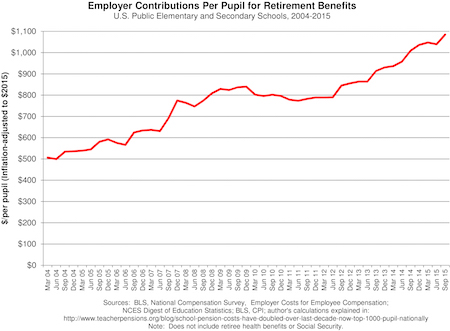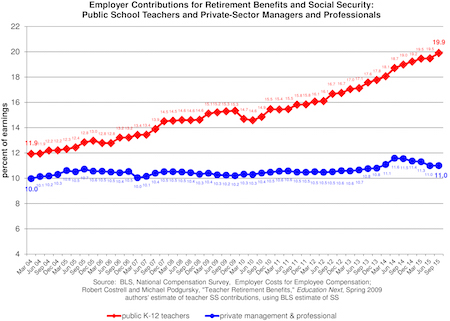Earlier this year Robert M. Costrell published data showing how much school districts nationwide now spend on pensions for public school employees. He calculated that, on average, districts were spending over $1000 per pupil on pensions. These costs had risen dramatically; in 2004 districts were only spending about $500 per pupil. And these costs do not include contributions to Social Security, the costs of retiree health benefits, or the pension contributions of the school employees themselves.
Costrell has now updated his calculations to include data released later in 2015, including the new school year, and he finds that pension costs are continuing to rise. As of September 2015 pension costs were $1,085 per pupil.
Figure 1 below shows the dramatic rise in pension costs. (See Costrell’s earlier blog entry, “School Pension Costs Have Doubled Over the Last Decade, Now Top $1,000 Per Pupil Nationally, to see how these figures were calculated.)

Given that school districts now spend about $11,800 per pupil on average, the $1,085 spent on employee pensions represents a significant amount of money that might have otherwise been spent in ways that would benefit student learning.
Pension costs for public school teachers are rising at rates that far outstrip those of employees in comparable occupations in the private sector. The blue line in Figure 2 below shows employer costs for retirement benefits for private-sector managers and professionals as a percent of earnings from 2004 to 2015. These costs (which include Social Security, but not retiree health benefits or employee pension contributions) have been essentially constant since 2004, at 10–11 percent. But for public school teachers, these costs have skyrocketed from about 12 percent of earnings in 2004 to 15 percent in 2009, when Costrell and Podgursky first published these data in Education Next, to 20 percent today.

The reasons for the dramatic rise in pension costs for school employees vary from state to state, but the main cause is payments to amortize the enormous unfunded liabilities that have come to exist as states and districts have deferred payments on benefits they have promised to their teachers and other employees.
These are trends worth watching: Costrell updates these estimates quarterly at his website.
— Education Next


